Hima Oumarou Souleymane1, Mohamedou Cheibany Bneijeck2
1PhD Student of College of Journalism and Communication, Hebei University, Baoding, China
2Nouakchott University Mauritania
Correspondence to: Hima Oumarou Souleymane, PhD Student of College of Journalism and Communication, Hebei University, Baoding, China.
| Email: |  |
Copyright © 2024 The Author(s). Published by Scientific & Academic Publishing.
This work is licensed under the Creative Commons Attribution International License (CC BY).
http://creativecommons.org/licenses/by/4.0/

Abstract
In Niger, youth seem to be more focused on modern tools of communication, thanks to the development of information and communication technologies (ICT), while abandoning traditional means of communication. Thus, this paper aims to highlight the views of young generations towards traditional communication tools. The study was conducted through a survey of young students from universities and/or high schools, those who have already finished their studies (graduated students), and from the main cities of Niger. The results revealed the attachment of young people to new communication and information technologies and, especially, the use of modern platforms such as social media.
Keywords:
Attitude, Young generation, Niger, Traditional communication
Cite this paper: Hima Oumarou Souleymane, Mohamedou Cheibany Bneijeck, The Attitude of Young Generation towards Traditional Communication: The Case of Niger, American Journal of Linguistics, Vol. 10 No. 1, 2024, pp. 9-13. doi: 10.5923/j.linguistics.20241001.02.
1. Introduction
The development of information and communication technologies impacts the lives of young people in Niger. Social media are the main focus of this new generation. Even modern tools such as books, newspapers, radio, and television have become traditional. Thus, the young generation in Niger is in a transition between modernity and tradition. As in the rest of Africa, Niger, in particular, has seen the advent of modern communication and information sciences, leading to a major evolution and transformation in the way we communicate and receive information. However, traditional communication still plays a crucial role in the dissemination of information in rural and urban areas. Nevertheless, this communication form faces great challenges that hinder its development, and it remains unknown to young people who are submerged in modern times with smartphones and the Internet.In spite of all the problems facing this traditional form of communication, it is, however, an integral part of the Nigerien cultural identity and a means of social cohesion and peace between the different ethnic groups in Niger. The young generation has to be taught the importance of this form of communication. They have not fully mastered the traditional communication tool, which is a cultural symbol and a cultural heritage handed down from one generation to the next. This document, therefore, focuses on young people's attitudes toward traditional communications. The objective is two fold: to understand the attitudes of the younger generation towards traditional communication and to highlight the socio-bibliography of young people in Niger and their knowledge of traditional communication tools. This document is structured as follows: literature review, study methodology, main results, discussion, and conclusion.
2. Literature Review
African youth in general and those of Niger in particular have rapidly integrated the virtual world. The literature on the attitude of African youth towards traditional communication is vast and diverse. Some authors have focused their analysis on the impact of information and communication technologies (ICT) on traditional communication in Africa and the attitudes of youth toward these new forms of media (Mudhai, Tettey, and Banda, 2009; Meyer, 2017; Prah, 2004; Sounaye, 2011; Bussotti, 2015). In this aspect, Meyer (2016) explores how African youth use traditional communication to negotiate their relationship with religion and spiritual practices. while others focus on the functions of traditional communications. Nyamnjoh (2005) examines how traditional communication can be used to strengthen democracy and citizenship in Africa. Ngwainmbi (2019) explores the interaction between traditional African religion and African youth, focusing on the way young people are engaged in practices and traditional beliefs. Middleton (1999) examines how traditional African thought systems can be used to inform current debates about science and technology in Africa and how this may be perceived by African youth. Prah (2004) examines how traditional communication systems in Africa influence the identity and self-perception of African youth. The theory of persuasion can be used to influence the attitude of the young generation towards traditional communication. In fact, this theory stresses that to persuade an audience, it is necessary to create a message adapted to the audience and to use effective communication techniques (Festinger, 1962; Becker, 1960; and Petty and Cacioppo, 1986). Thus, actors in traditional communication can adopt this theory in order to transmit cultural heritage to the next generation.
3. Methodology of the Study
This section presents the methodology of the study: research method and data collection. This paper has focused on researchers' contributions to quantitative research methodology, mainly on research design, data collection, and analysis used in social science research (Ivankova, Creswell, and Stick, 2006; Creswell et al., 2007; Trochim and Donnelly, 2001; and Jackson and Trochim, 2002). This study uses quantitative research, mainly a survey carried out among young students from Niamey, the capital city, and Maradi, the economic capital city, two main cities of Niger. The choice of respondent was guided by the criteria of being a student aged between 18 and 35 years old. The study used questionnaires to collect data from a sample of young people to find out about their perceptions and knowledge of traditional communication (Clark et al., 2008; Jackson and Trochim, 2002; Johnson and Onwuegbuzie, 2004).In this study, "numerical data" was collected using closed-ended questions, mainly multiple-choice questions. As the target audience is a part of the youth population, responses for each option are easily quantified. Excel software was used to analyze survey results.
4. Findings and Interpretations
4.1. Demographically Characteristics of Respondents
The young people who participated in this study are generally students from high school and universities earning bachelor, master, and PhD degrees.
4.1.1. Gender Distribution
The proportion of women was low compared to men, this can be explained by the fact that educated women are few in Niger. Table 1 present the distribution of genderTable 1. Gender distribution
 |
| |
|
4.1.2. Major of Study
All study levels were included Bachelors (50.37%), Masters (27.07%) and Doctorates (1.5%) and high school as presented in table 2.Table 2. Major of Study
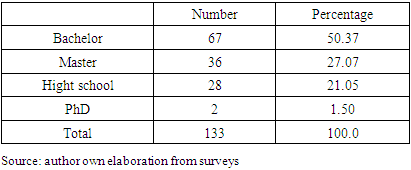 |
| |
|
4.1.3. Place of Residence
Respondents are coming from two places, cities and villages as presented in table 3.Table 3. Place of residence
 |
| |
|
4.1.4. Age Distribution
Age distribution reveals a weak proportion of adult people whose age is between 30 and 35 years, as presented in table 4.Table 4. Age distribution
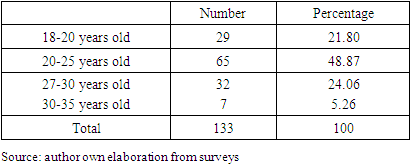 |
| |
|
4.1.5. Marital Status
Responses indicate that single are more dominant than married this can be explained by the fact that major respondents are young as presented in table 5.Table 5. Marital status
 |
| |
|
4.1.6. Money Spends by Month
The young people who took part in this research used their income (financial resources provided by their parents or from their student grants) to take out Internet packages in order to be able to connect to the service offered by foreign or local mobile phone companies. On the mobile phone market, you can find very affordable prices for new handsets manufactured in China or on the local second-hand market. The young people said that these two markets have greatly facilitated access to the Internet, even for young people in the village. Despite the electricity problems, which are an obstacle to better use of mobile devices. Table 6 presented the amount of money spent on modern communications per month.Table 6. Money spends by month
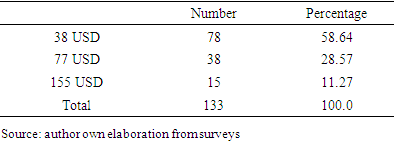 |
| |
|
4.2. The Attitude of Young Generation Towards Traditional Communication
The results of the research through our questionnaires clearly showed the attitude of young Nigeriens towards traditional means of communication. Many of these young people do not feel concerned by this form of communication, which continues to be used in several regions of Niger, not only in the villages, but even in the large districts of the capital, Niamey, where the traces of traditional communication still serve the population. There is a generational conflict between the years 50 and the year 2000, who have no knowledge of traditional means of communication or traditional communication players. Few people are familiar with traditional tools and the role of traditional communication players, who are the guardians of tradition in Niger society. The young people who have some knowledge of traditional communication and the tools of traditional communication are mostly those who were born in the village. Table 7, present the results collected in the field.Table 7. Knowledge of traditional communication forms by youth
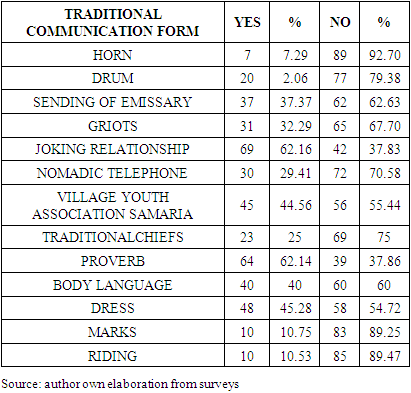 |
| |
|
4.3. The Attitude of Young Generation Towards Modern Communication Tools
An analysis of table 8 shows the attachment of these young people to new communication and information technologies, and especially their use of modern platforms, especially WhatsApp (99.2%), which for the young people taking part in this research is an essential means of receiving and transmitting information.Table 8. Attitude of young generation towards Medias
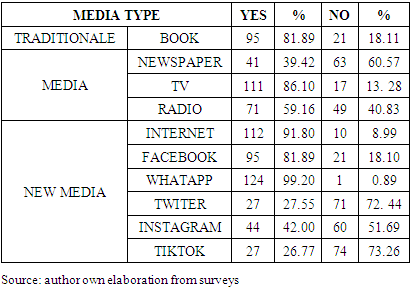 |
| |
|
The results show us a different reality with regard to so-called modern media such as radio and television, which, thanks to the challenge posed by the rise of new technologies among young people in Niger, have now become traditional tools. Even books and newspapers are confronted with this modern phenomenon (ICTs), which means that young people are facing a transition between modernity and tradition.
5. Discussion
Nigerien youths aged 19 to 20 are completely unaware of the existence of this traditional communication; for them, ICT answers their daily needs (Ngwainmbi, 2019). The above results highlight the opinions of the young generation and are in line with some authors who argue that, nowadays, youth are not more aware of the existence of traditional media (Mudhai et al., 2009; Meyer, 2016). Despite the fact that traditional means of communication are neglected by the youth, they not only play the role of informing (Nyamnjoh, 2005). Meanwhile, the new technologies should be a means of popularizing traditional communication; value them and consider their actors, who are holders of knowledge on ethics, good behavior, and living together (Maria. M. 2021).These values can be transmitted to young people, especially with the affordable prices of smart phones. Almost all the Nigerien youth have these tools to connect; it's a reality in Africa, not only in Niger. With the products made in China, especially cell phones, the Nigerien youth, thanks to their source of income, can afford these devices to communicate. It is important to note that in our traditional African society, the young people go through an initiation or a transmission of values, thanks to the channels of the wise men, or the members of the family. In this aspect, the results of this study are in line with the works of Mudhai et al. (2009). The author makes a very interesting and in-depth analysis of the impact of information and communication technologies (ICTs) on traditional communication in Africa and on the attitudes of young people towards these new forms of media (K. Madhusudan, 2006).Traditional communication is often neglected in the literature on digital media. However, it is important to emphasize this aspect that constitutes a real problem for traditional communication, especially since the influence of new technologies has greatly affected the youth by disconnecting them from their cultural values T. Mathiyazhagan and Jagjyot et all (2015). Therefore, some issues arise as cybercrime arises, and it is not to be neglected in many countries in Africa. Young people are used to it, especially those in big cities (Sounaye, 2011). This thesis analysis showed us that the rise of modernization in our cities is not bad at all; however, the use that the youth make of the Internet negatively impacts the value of traditional communication that teaches cultural values to this youth. These analyses are in line with the work of Prah (2004), who stresses the impact of traditional communication on the self-perception of youth. Thus, this paper highlights the importance of teaching youth traditional communication. especially in the transmission of ancestral knowledge that comes from traditional communication. During our research on the field, many of these young Nigerien do not know the name of some traditional means of communication, such as the sending of an emissary or the existence of samaria, which are houses of youth and places of sharing information before the coming of the internet. So, to diffuse the knowledge of traditional communication, it is necessary to first target how to make it. In this case, ICT is requested, and the academics and experts in communication studies will have to play a role in the transmission and safeguarding of this form of communication, which is always functional for other layers of Nigerien society. Hence, traditional communication is still the main means of communication in some parts of Niger due to the financial means to offer a smart phone or the non-knowledge of the use of modern tools of communication, especially in zones where the coverage of the network is weak, there is the absence of internet, or there are problems with alphabetization.
6. Conclusions
The main objective of this paper was to highlight the attitude of the young generation towards traditional communication. The study focused on surveys to collect data from the young generation. The results revealed the sociodemographic profiles of youth in Niger. This young generation is aged between 18 and 35 and is mainly made up of students. Young people in Niger have little or no knowledge of traditional communication tools. Meanwhile, this paper advocates the dissemination of knowledge about traditional communication by the various players (government, parents, community leaders, etc.) to young people through training programs in schools and universities, as well as social and cultural activities. The relationship between new communication technologies and traditional communication in Niger is complex and constantly evolving. While ensuring that all citizens have access to effective communication tools that are compatible with modern society, traditional communication should be preserved as a cultural value and heritage for future generations. This paper has made a solid contribution to communication in Niger by highlighting the attitude of the young generation towards traditional communication in this country. However, the paper has one main limitation: the survey was conducted mainly in two towns in Niger. Future research on traditional communication in Niger could survey a large sample of respondents in many Niger towns.
References
| [1] | Becker, H. S. (1960). Notes on the concept of commitment. Aùerican Journal of Sociology, 66 (1), 32-40. |
| [2] | Bussotti. L. (2015) ‘Short Reflections on the history of African Communication’. Historia? Communicacion Social. 20 (1), 205-222. |
| [3] | Creswell, J. W., Hanson, W. E., Clark Plano, V. L., & Morales, A. (2007). Qualitative research designs: Selection and implementation. The counseling psychologist, 35(2), 236-264. |
| [4] | Clark, V. L. P., Creswell, J. W., Green, D. O. N., & Shope, R. J. (2008). Mixing quantitative and qualitative approaches. Handbook of emergent methods, 363, 363-387. |
| [5] | Festinger, L. (1962). A theory of cognitive dissonance (Vol. 2). Stanford university press. |
| [6] | Ivankova, N. V., Creswell, J. W., & Stick, S. L. (2006). Using mixed-methods sequential explanatory design: From theory to practice. Field methods, 18(1), 3-20. |
| [7] | Jackson, K. M., & Trochim, W. M. (2002). Concept mapping as an alternative approach for the analysis of open-ended survey responses. Organizational research methods, 5(4), 307-336. |
| [8] | Johnson, R. B., & Onwuegbuzie, A. J. (2004). Mixed methods research: A research paradigm whose time has come. Educational researcher, 33(7), 14-26. |
| [9] | Meyer, U. (2016). Négocier L'accès, la Propriété Et L'autorité Publique en Marge de la Ville: Enjeux Fonciers À Niamey Et Production D'Etat Au Niger (Doctoral dissertation entitle: negotiate the access, property and public authority in the city: properties challenges in Niamey and state production in Niger). |
| [10] | Middleton, J. (1999). Lugbara religion: ritual and authority among an East African people (Vol. 12). LIT Verlag Münster. |
| [11] | Mudhai, O., Tettey, W., & Banda, F. (Eds.). (2009). African media and the digital public sphere. Springer. |
| [12] | Ngwainmbi, E. K. (2019). Social media use among the youth and working class: Conditions for remediating globalization and cultural space. Media in the global context: Applications and interventions, 49-93. |
| [13] | Nyamnjoh, F. F. (2005). Africa's Media, Democracy and the Politics of Belonging. London Zeb Books. |
| [14] | Petty, R. E., & Cacioppo, J. T. (1986). The elaboration likelihood model of persuasion (pp. 1-24). Springer New York. https://richardepetty.com/wp-content/uploads/2019/01/1986-advances-pettycacioppo.pdf. |
| [15] | Prah, K. K. (2004). African wars and ethnic conflicts: Rebuilding failed states. Human Development Report 2004. |
| [16] | Trochim, W. M., & Donnelly, J. P. (2001). Research methods knowledge base (Vol. 2). Macmillan Publishing Company, New York: Atomic Dog Pub. |
| [17] | Sounaye, A. (2011). Doing development, the Islamic way in contemporary Niger. Bulletin del’APAD, 33 [en ligne]. Accessible sur http://apad.revues.org/4084. |
| [18] | Maria. M. (2021) The traditional communication theory and the effective use of social media in public relations. Acritical reflection. |
| [19] | David Westerman. Brandon Van Der Heide Katherine A. Klein. Joseph B. Walther. (2008) How do people really seek information about others?: Information seeking across Internet and traditional communication channels. Journal of Computer-Mediated Communicationdoi: 10.1111/j.1083-6101.2008.00418.x. |
| [20] | Scott C. D’Urso and Stephen A. Rains (2008) Examining the scope of channel expension a test of channel expension theory with new and traditional communication media. Management Communication Quarterly Volume 21, Number 4. Sage Publications. 10.1177/0893318907313712. |
| [21] | T. Mathiyazhagan1, Jagjyot Kaur2, M. Ravindhar3 and G.P. Devrani4 (2015) Traditional Media of Communication International Journal of Social Science, Volume 4, No. 1, pp. 159-169: 10.5958/2321-5771.2015.00011.3. |



 Abstract
Abstract Reference
Reference Full-Text PDF
Full-Text PDF Full-text HTML
Full-text HTML






